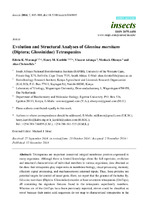| dc.description.abstract | Tetraspanins are important conserved integral membrane proteins expressed in
many organisms. Although there is limited knowledge about the full repertoire, evolution and structural characteristics of individual members in various organisms, data obtained so far show that tetraspanins play major roles in membrane biology, visual processing, memory, olfactory signal processing, and mechanosensory antennal inputs. Thus, these proteins are potential targets for control of insect pests. Here, we report that the genome of the tsetse fly, Glossina morsitans (Diptera: Glossinidae) encodes at least seventeen tetraspanins (GmTsps), all containing the signature features found in the tetraspanin superfamily members. Whereas six of the GmTsps have been previously reported, eleven could be classified as novel because their amino acid sequences do not map to characterized tetraspanins in the available protein data bases. We present a model of the GmTsps by using GmTsp42Ed, whose presence and expression has been recently detected by transcriptomics and proteomics analyses of G. morsitans. Phylogenetically, the identified GmTsps segregate into three major clusters. Structurally, the GmTsps are largely similar to vertebrate tetraspanins. In view of the exploitation of tetraspanins by organisms for survival, these proteins could be targeted using specific antibodies, recombinant large extracellular loop (LEL) domains, small-molecule mimetics and siRNAs as potential novel and efficacious putative targets to combat African trypanosomiasis by killing the tsetse fly vector. | en_US |

